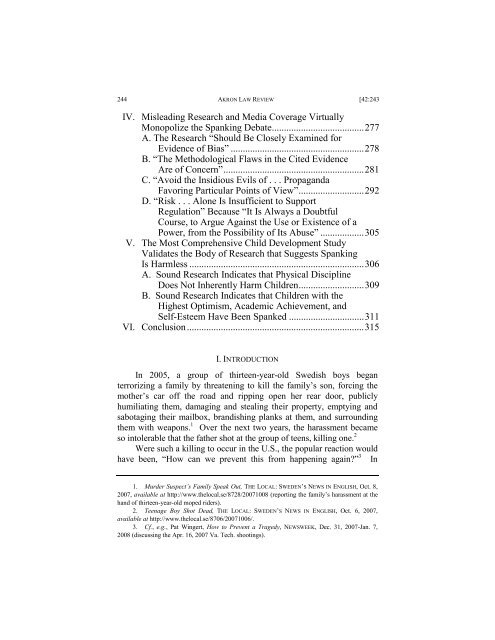The Science and Statistics Behind Spanking Suggests that
The Science and Statistics Behind Spanking Suggests that
The Science and Statistics Behind Spanking Suggests that
You also want an ePaper? Increase the reach of your titles
YUMPU automatically turns print PDFs into web optimized ePapers that Google loves.
11-FULLER_FINAL_AFTERPROOF.DOC 2/17/2009 8:50 AM<br />
244 AKRON LAW REVIEW [42:243<br />
IV. Misleading Research <strong>and</strong> Media Coverage Virtually<br />
Monopolize the <strong>Spanking</strong> Debate ...................................... 277<br />
A. <strong>The</strong> Research “Should Be Closely Examined for<br />
Evidence of Bias” ....................................................... 278<br />
B. “<strong>The</strong> Methodological Flaws in the Cited Evidence<br />
Are of Concern” .......................................................... 281<br />
C. “Avoid the Insidious Evils of . . . Propag<strong>and</strong>a<br />
Favoring Particular Points of View” ........................... 292<br />
D. “Risk . . . Alone Is Insufficient to Support<br />
Regulation” Because “It Is Always a Doubtful<br />
Course, to Argue Against the Use or Existence of a<br />
Power, from the Possibility of Its Abuse” .................. 305<br />
V. <strong>The</strong> Most Comprehensive Child Development Study<br />
Validates the Body of Research <strong>that</strong> <strong>Suggests</strong> <strong>Spanking</strong><br />
Is Harmless ........................................................................ 306<br />
A. Sound Research Indicates <strong>that</strong> Physical Discipline<br />
Does Not Inherently Harm Children ........................... 309<br />
B. Sound Research Indicates <strong>that</strong> Children with the<br />
Highest Optimism, Academic Achievement, <strong>and</strong><br />
Self-Esteem Have Been Spanked ............................... 311<br />
VI. Conclusion ......................................................................... 315<br />
I. INTRODUCTION<br />
In 2005, a group of thirteen-year-old Swedish boys began<br />
terrorizing a family by threatening to kill the family’s son, forcing the<br />
mother’s car off the road <strong>and</strong> ripping open her rear door, publicly<br />
humiliating them, damaging <strong>and</strong> stealing their property, emptying <strong>and</strong><br />
sabotaging their mailbox, br<strong>and</strong>ishing planks at them, <strong>and</strong> surrounding<br />
them with weapons. 1 Over the next two years, the harassment became<br />
so intolerable <strong>that</strong> the father shot at the group of teens, killing one. 2<br />
Were such a killing to occur in the U.S., the popular reaction would<br />
have been, “How can we prevent this from happening again?” 3 In<br />
1. Murder Suspect’s Family Speak Out, THE LOCAL: SWEDEN’S NEWS IN ENGLISH, Oct. 8,<br />
2007, available at http://www.thelocal.se/8728/20071008 (reporting the family’s harassment at the<br />
h<strong>and</strong> of thirteen-year-old moped riders).<br />
2. Teenage Boy Shot Dead, THE LOCAL: SWEDEN’S NEWS IN ENGLISH, Oct. 6, 2007,<br />
available at http://www.thelocal.se/8706/20071006/.<br />
3. Cf., e.g., Pat Wingert, How to Prevent a Tragedy, NEWSWEEK, Dec. 31, 2007-Jan. 7,<br />
2008 (discussing the Apr. 16, 2007 Va. Tech. shootings).

















